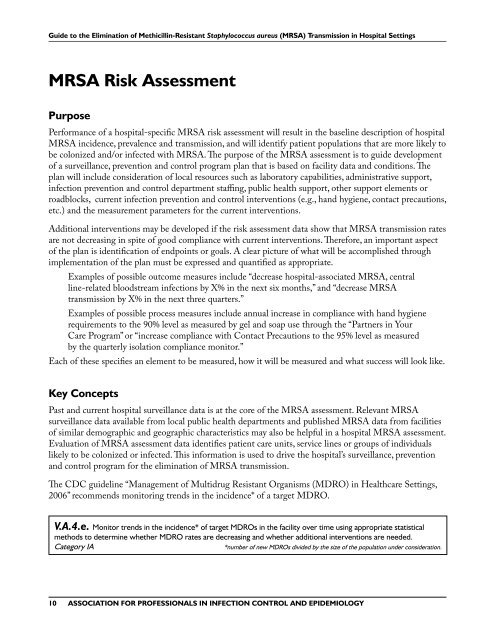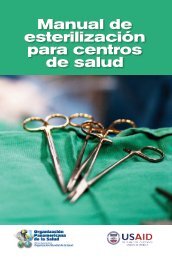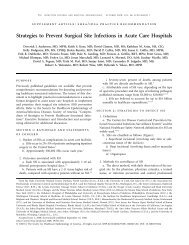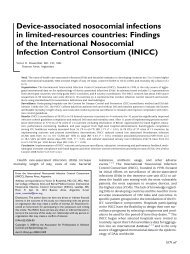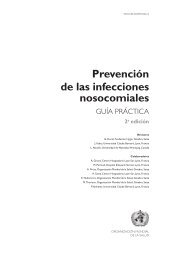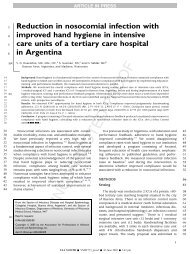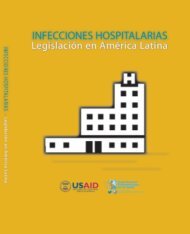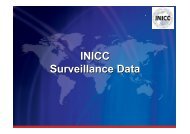APIC MRSA Elimination Guideline
APIC MRSA Elimination Guideline
APIC MRSA Elimination Guideline
Create successful ePaper yourself
Turn your PDF publications into a flip-book with our unique Google optimized e-Paper software.
Guide to the <strong>Elimination</strong> of Methicillin-Resistant Staphylococcus aureus (<strong>MRSA</strong>) Transmission in Hospital Settings<strong>MRSA</strong> Risk AssessmentPurposePerformance of a hospital-specific <strong>MRSA</strong> risk assessment will result in the baseline description of hospital<strong>MRSA</strong> incidence, prevalence and transmission, and will identify patient populations that are more likely tobe colonized and/or infected with <strong>MRSA</strong>. The purpose of the <strong>MRSA</strong> assessment is to guide developmentof a surveillance, prevention and control program plan that is based on facility data and conditions. Theplan will include consideration of local resources such as laboratory capabilities, administrative support,infection prevention and control department staffing, public health support, other support elements orroadblocks, current infection prevention and control interventions (e.g., hand hygiene, contact precautions,etc.) and the measurement parameters for the current interventions.Additional interventions may be developed if the risk assessment data show that <strong>MRSA</strong> transmission ratesare not decreasing in spite of good compliance with current interventions. Therefore, an important aspectof the plan is identification of endpoints or goals. A clear picture of what will be accomplished throughimplementation of the plan must be expressed and quantified as appropriate.Examples of possible outcome measures include “decrease hospital-associated <strong>MRSA</strong>, centralline-related bloodstream infections by X% in the next six months,” and “decrease <strong>MRSA</strong>transmission by X% in the next three quarters.”Examples of possible process measures include annual increase in compliance with hand hygienerequirements to the 90% level as measured by gel and soap use through the “Partners in YourCare Program” or “increase compliance with Contact Precautions to the 95% level as measuredby the quarterly isolation compliance monitor.”Each of these specifies an element to be measured, how it will be measured and what success will look like.Key ConceptsPast and current hospital surveillance data is at the core of the <strong>MRSA</strong> assessment. Relevant <strong>MRSA</strong>surveillance data available from local public health departments and published <strong>MRSA</strong> data from facilitiesof similar demographic and geographic characteristics may also be helpful in a hospital <strong>MRSA</strong> assessment.Evaluation of <strong>MRSA</strong> assessment data identifies patient care units, service lines or groups of individualslikely to be colonized or infected. This information is used to drive the hospital’s surveillance, preventionand control program for the elimination of <strong>MRSA</strong> transmission.The CDC guideline “Management of Multidrug Resistant Organisms (MDRO) in Healthcare Settings,2006” recommends monitoring trends in the incidence* of a target MDRO.V.A.4.e. Monitor trends in the incidence* of target MDROs in the facility over time using appropriate statisticalmethods to determine whether MDRO rates are decreasing and whether additional interventions are needed.Category IA*number of new MDROs divided by the size of the population under consideration.10ASSOCIATION FOR PROFESSIONALS IN INFECTION CONTROL AND EPIDEMIOLOGY


